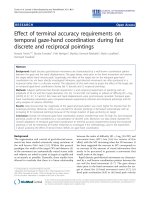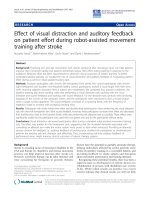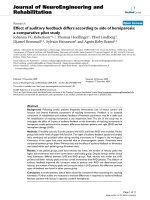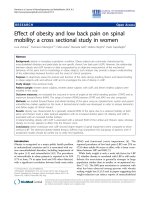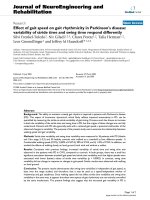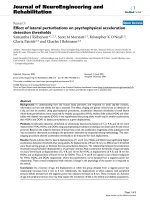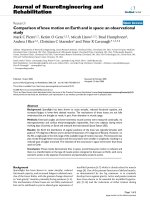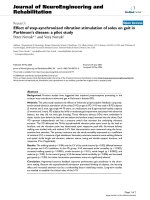báo cáo hóa học: " Effect of pioglitazone treatment on behavioral symptoms in autistic children" pptx
Bạn đang xem bản rút gọn của tài liệu. Xem và tải ngay bản đầy đủ của tài liệu tại đây (387.24 KB, 7 trang )
BioMed Central
Page 1 of 7
(page number not for citation purposes)
Journal of Neuroinflammation
Open Access
Case study
Effect of pioglitazone treatment on behavioral symptoms in autistic
children
Marvin Boris*
1
, Claudia C Kaiser
2
, Allan Goldblatt
1
, Michael W Elice
1
,
Stephen M Edelson
3
, James B Adams
4
and Douglas L Feinstein
2
Address:
1
77 Froehlich Farm Blvd Woodbury, New York 11797, USA,
2
Department of Anesthesiology, University of Illinois, Chicago, IL, 60612,
USA,
3
Autism Research Institute, 4182 Adams Ave, San Diego, CA 92116, USA and
4
Arizona State University, PO Box 876006, Tempe, AZ 85287-
6006, USA
Email: Marvin Boris* - ; Claudia C Kaiser - ; Allan Goldblatt - ;
Michael W Elice - ; Stephen M Edelson - ; James B Adams - ;
Douglas L Feinstein -
* Corresponding author
Abstract
Introduction: Autism is complex neuro-developmental disorder which has a symptomatic
diagnosis in patients characterized by disorders in language/communication, behavior, and social
interactions. The exact causes for autism are largely unknown, but is has been speculated that
immune and inflammatory responses, particularly those of Th2 type, may be involved.
Thiazolidinediones (TZDs) are agonists of the peroxisome proliferator activated receptor gamma
(PPARγ), a nuclear hormone receptor which modulates insulin sensitivity, and have been shown to
induce apoptosis in activated T-lymphocytes and exert anti-inflammatory effects in glial cells. The
TZD pioglitazone (Actos) is an FDA-approved PPARγ agonist used to treat type 2 diabetes, with a
good safety profile, currently being tested in clinical trials of other neurological diseases including
AD and MS. We therefore tested the safety and therapeutic potential of oral pioglitazone in a small
cohort of children with diagnosed autism.
Case description: The rationale and risks of taking pioglitazone were explained to the parents,
consent was obtained, and treatment was initiated at either 30 or 60 mg per day p.o. A total of 25
children (average age 7.9 ± 0.7 year old) were enrolled. Safety was assessed by measurements of
metabolic profiles and blood pressure; effects on behavioral symptoms were assessed by the
Aberrant Behavior Checklist (ABC), which measures hyperactivity, inappropriate speech,
irritability, lethargy, and stereotypy, done at baseline and after 3–4 months of treatment.
Discussion and evaluation: In a small cohort of autistic children, daily treatment with 30 or 60
mg p.o. pioglitazone for 3–4 months induced apparent clinical improvement without adverse
events. There were no adverse effects noted and behavioral measurements revealed a significant
decrease in 4 out of 5 subcategories (irritability, lethargy, stereotypy, and hyperactivity). Improved
behaviors were inversely correlated with patient age, indicating stronger effects on the younger
patients.
Conclusion: Pioglitazone should be considered for further testing of therapeutic potential in
autistic patients.
Published: 05 January 2007
Journal of Neuroinflammation 2007, 4:3 doi:10.1186/1742-2094-4-3
Received: 13 November 2006
Accepted: 05 January 2007
This article is available from: />© 2007 Boris et al; licensee BioMed Central Ltd.
This is an Open Access article distributed under the terms of the Creative Commons Attribution License ( />),
which permits unrestricted use, distribution, and reproduction in any medium, provided the original work is properly cited.
Journal of Neuroinflammation 2007, 4:3 />Page 2 of 7
(page number not for citation purposes)
Introduction
Autism, the most common of the group of disorders col-
lectively referred to as Autism Spectrum Disorders (ASD),
is a complex neurological disease of unknown etiology.
The incidence of autism is estimated to be 1 per 166 [1]
with a male to female ratio of 4:1. Autism has been found
throughout the world in families of all racial, ethnic and
social backgrounds. Although accumulating evidence sug-
gests that genetic, environmental, inflammatory, immu-
nological, and metabolic factors play a prominent role in
this disease [2-7], the precise causes remain to be deter-
mined.
Altered immune responses in children with ASD are well
documented. Autoimmune disorders of thyroiditis, coli-
tis, myelin basic protein autoantibodies, and diabetes are
prevalent in children with ASD. Stubbs (1976) published
that 5 of 13 autistic children had no detectable rubella
antibodies despite prior immunization [7]. An additional
study showed peripheral mononuclear cells had a
decreased proliferative response to mitogenic stimulation
compared to normal children [8]. These findings of
abnormal T-lymphocyte function have been replicated by
other investigators [9,10]. Inflammatory responses in
ASD have also been reported to occur in brain, for exam-
ple neuroinflammatory processes involving both micro-
glia and astroglia were found on post mortem
examination in autistic children with elevated cytokine
levels in the cerebral spinal fluid [11,12]. Children with
ASD have increased cytokines of Th2 and Th1 arms of the
immune response with Th2 predominant without an
increase in IL10 [13].
Peroxisome proliferator-activated receptor gamma
(PPARγ) is a nuclear hormone receptor originally charac-
terized by its ability to regulate adipocyte differentiation
and gene transcription [14]. PPARγ agonists include fatty
acids, non-steroidal anti-inflammatory drugs (NSAIDs),
the natural compound 15-deoxy12,14-prostaglandin-J2
(PGJ2), and members of the class of synthetic drugs
termed thiazolidinediones (TZDs) which include piogli-
tazone (Actos) and rosiglitazone (Avandia). TZDs were
originally designed as anti-diabetic drugs due to their
insulin sensitizing effects, and several are now in clinical
use. In addition to insulin sensitizing effects, TZDs also
exert anti-inflammatory effects on a variety of cell types,
and for this reason some are being considered for treat-
ment of inflammatory diseases including artherosclerosis
[15], psoriasis [16,17], and inflammatory bowel disease
[18-21]. TZDs also reduce inflammatory activation of
brain glial cells, and increase metabolic activities in glial
cells which can lead to increased glucose uptake, lactate
production, and mitochondrial function [22,23]. Further-
more, pioglitazone can cross the BBB, [24] suggesting pos-
sible direct effects on brain physiology, which could
positively influence possible abnormalities in regional
brain glucose utilization [25] or dysregulation of func-
tional activity [26] as reported to occur ASD.
The safety and efficacy of pioglitazone has been estab-
lished by clinical studies worldwide [27,28] and since
FDA approval, pioglitazone has been prescribed to several
million patients. The adverse events associated with TZDs
including pioglitazone are generally mild and transient,
and those effects returned to baseline upon withdrawal
from, or completion of the studies. Two recent studies for
the treatment of diabetes in adolescents point to a good
safety profile for Actos in younger populations [29,30].
Studies with PPARγ drugs in animal models of neurologi-
cal conditions have led to clinical testing of these drugs in
Alzheimer's disease (AD) and multiple sclerosis (MS)
[31,32]. These properties of PPARγ agonists make them
promising candidates for a therapeutic approach to influ-
ence the clinical course of ASD. In this report we discuss
initial findings using pioglitazone to treat children with
autism, which provides the rationale for design of larger
clinical trials.
Case description
Population
The autistic children all were patients of Marvin Boris,
MD, Allan Goldblatt, PA, and Michael Elice, MD. Twenty-
five children and adolescents participated in this study.
The mean age was 7.9 ± 3.5 years, with a range from 3 to
17 years. There were 22 males and 3 females. All of the
participants received an independent diagnosis of Autism
Spectrums Disorder (ASD) from an independent clinician
and/or agency. None of the children had diagnosed
Asperger's Disorder (a mild variant of ASD with higher
social functioning) or PDDNOS (Pervasive Developmen-
tal Disorder – Not Otherwise Specified, a condition with
social or behavioral impairments but which do not meet
the DSM-IV criteria for ASD). The diagnosis of autism was
initially established by a board certified pediatric neurol-
ogist, developmental pediatrician, or psychiatrist with
experience in ASD. In addition, at the first visit to the
offices of the treating physician, the child had to meet the
DSM-IV checklist criteria for ASD. All the children had
been receiving behavioral and educational therapies.
These included speech, occupational, and physical ther-
apy, applied behavioral analysis, and auditory integration
therapy. The children had also received various biomedi-
cal interventions for at least one year. These included dairy
and gluten free diet, metabolic treatment with supple-
ments to known deficiencies such as MTHFR (methylene-
tetrahydrofolate reductase), treatment with intravenous
gamma globulin or secretin, vitamin supplementation,
and heavy metal chelation. The children who responded
poorly (no noticeable improvements in cognitive, social,
behavior, or language skills) for at least one year to bio-
Journal of Neuroinflammation 2007, 4:3 />Page 3 of 7
(page number not for citation purposes)
medical, behavioral, or educational therapies were
selected to be treated with pioglitazone as part of the rou-
tine health care treatment, based on papers suggesting
that ASD includes an auto-immune or inflammatory com-
ponent [33,34], and that pioglitazone can reduce T-cell
activation and Th2-type cytokine production, both impli-
cated in ASD [35-38]. The rationale and risks of taking
pioglitazone were explained to the parents, and parental
written consents were obtained for all participants. A ret-
rospective review of their personal medical records was
approved by the Internal Review Board of Arizona State
University.
Comorbities
The autistic population has well-known auto-immunne
comorbidities. In this group of autistic children, 7/25
(28%) had thyroiditis, 8/25 (32%) had colitis, 8/25
(32%) had PANDAS (Pediatric acquired neurological dis-
order associated with streptococcus), 20/25 (80%) had
allergic diseases, and 7/25 (28%) were positive for serum
antibodies to myelin basic protein. In addition 2/25 had
seizures prior to being treated with pioglitazone.
Treatment
Children were prescribed pioglitazone either 30 mg per
day, p.o. for ages 3–5 years old; or 60 mg per day for ages
6–17 years old. These children were followed with
monthly complete blood counts, glucose and insulin lev-
els, and serum metabolic assays.
Analysis
The participants' parents completed the Aberrant Behav-
ior Checklist (ABC) prior to the administration of piogli-
tazone and then at a follow-up assessment, 12 or 16 weeks
later. There are five subscales on the ABC, consisting of 58
questions. The subscales are: hyperactivity, inappropriate
speech, irritability, lethargy, and stereotypy. Each ques-
tion was rated on a 4-point scale: 0 = 'not a problem,' 1 =
'the behavior is a problem but slight in degree,' 2 = 'the
problem is moderately serious,' and 3 = 'the problem is
severe in degree.' 'The ABC has been shown to be a valid
and reliable procedure to evaluate treatment efficacy [39-
41]. Each of the five subscales was analyzed using paired
t-tests. The relationship between age and amount of
behavior change was examined using Pearson product
correlations
Outcomes
There were no significant abnormalities observed in
standard blood analyses in the group of 25 autistic chil-
dren treated with pioglitazone for up to 4 months (Table
1). Over the course of treatment, there were no elevations
in hemoglobin, creatine, BUN (blood urea nitrogen) or
insulin levels. There were 2 incidents of slightly and tran-
siently elevated white blood counts and glucose levels,
and 3 incidents of slightly and transiently elevated liver
enzyme (ALT and AST) levels. All elevations resolved
without interventions.
A comparison of the mean scores for ABC subscales
between baseline and end of treatment for each of the
patients revealed that four of the five ABC subscales
decreased significantly following the administration of
pioglitazone (Figure 1). These subscales were hyperactiv-
ity, irritability, lethargy, and stereotypy. There was no
change in inappropriate speech; however, it should be
noted that the speech subscale is of limited value in chil-
dren with autism who lack or have very limited speech.
Of the 25 patients, 76% showed an improvement
(defined as >50% decrease in score) in at least one sub-
group; while 56% showed an improvement in two or
more subgroups, and 40% showed improvements in 3 or
more subcategories. If response rate is estimated as those
who showed >25% decrease in at least 2 of the 5 sub-
scales, then the percentage is much higher 71%. The
majority of patients (52%) showed an improvement
(>50%) in the hyperactivity subscale.
Significant inverse correlations (Figure 2) were detected
between age and the improvements calculated for irrita-
bility (P = 0.03), lethargy (P = 0.02) and hyperactivity (P
= 0.007). This indicates a tendency for younger partici-
pants to benefit more from pioglitazone than the older
participants.
Discussion and evaluation
The current study provides evidence that treatment with
the PPARγ agonist pioglitazone (Actos) does not induce
any significant adverse effects, and may have a beneficial
effect on patterns of aberrant social behavior in children
with diagnosed autism. Despite the small sample size (n
= 25 total), we observed statistically significant decreases
in 4 of the 5 subscales of the ABC after a relatively short (4
months) treatment with pioglitazone. It is yet not known
Table 1: Incidents of elevated blood values
#Pre
6
Mid Post
WBC
1
20 1 1
Glucose
2
21 1 0
AST
3
30 2 1
ALT
4,5
30 3 0
1
White blood cell counts, normal range 3.8 to 10.5 × 1000 cells per
mcl. Values of 11.0 and 12.0 recorded.
2
Glucose, normal range 70–99
mg/dl. Values of 102 and 106 recorded.
3
Aspartate aminotransferase,
normal range 10–40 IU/L. Values of 42, 48, and 45 recorded.
4
Alanine
aminotransferase, normal range 10–45 IU/L. Values of 56, 60, and 48
recorded.
5
ALT and AST elevations occurred in the same three
patients.
6
Pre, pre-trial; Mid, mid-trial; Post, post-trial.
Journal of Neuroinflammation 2007, 4:3 />Page 4 of 7
(page number not for citation purposes)
if these improvements are long lasting, or if they will con-
tinue after treatment is withdrawn. Although originally
approved for treatment of Type 2 diabetes in adults, recent
clinical trials of pioglitazone for treatment of diabetes in
adolescents suggest this drug will be well tolerated in
younger populations [29,30].
There is increasing evidence for an association of ASD
with various immune syndromes. It was reported that
66% of children with autism have a relative with an
autoimmune disease [42], and families of children with
PDD (Pervasive Development Disorder) have a higher
average number of autoimmune diseases than families of
healthy children [43]. Recently the occurrence of AITD
(Autoimmune Thyroid Disease) in first or second order
relatives was concluded to be a risk factor for those ASD
children who show regression (the early loss of already
established skills of communication or of social interac-
tions) [44]. The possibility therefore exists that pioglita-
zone influences some aspect of auto-immune nature in
ASD children.
It has been suggested that a Th2-like dysfunction may con-
tribute to the causes of ASD. In children with ASD, a pre-
ponderance of Th2-like (IL4, IL6, IL10) over Th1-like (IL2,
IFNg, IL1β) cytokines has been reported [45-48]. These
studies support the idea that a predominance of Th2
cytokines may be a factor in ASD. PPARγ agonists are
known to influence T-cell physiology, and although most
often they have been shown to reduce Th1-like cytokine
(IL1β, TNFa, IL12) production, in several studies they also
reduced Th2 responses. In CD4 cells, PGJ2 and the TZD
ciglitazone reduced IL4 production [35] and in EAE, the
animal model of Multiple Sclerosis, PGJ2 blocked splenic
T cell production of IL10 and IL4 [36]. PPARγ agonists
also reduce the clinical symptoms in animal models of
asthma, a disease which is also thought to be predomi-
nantly Th2 type involving IL4, IL5, and IL13 [37]. PPARγ
agonists have been shown to reduce IL4, IL5, and IL13
production from Tcells of mice with induced lung inflam-
mation [38,49]. However, in one study the TZDs
increased IL4 and IL10, and stimulated GATA3 expression
(a transcription factor which shifts cells towards Th2 phe-
Relationship of behavioral improvements to ageFigure 2
Relationship of behavioral improvements to age. Dif-
ferences in scores for the 5 subscales of the ABC were calcu-
lated and plotted versus patient age, and analyzed using
Graphpad Prism V4 assuming Gaussian distributions.
Effect of Pioglitazone on behavior improvementFigure 1
Effect of Pioglitazone on behavior improvement. The
average (mean ± s.d.) of the total scores for the 5 subscales
of the ABC was calculated for 25 patients before treatment
(baseline) and after 3–4 months of treatment with Pioglita-
zone. *, P < .05 unpaired T-test.
Journal of Neuroinflammation 2007, 4:3 />Page 5 of 7
(page number not for citation purposes)
notype) [50]; although in other studies PPARγ drugs were
shown to inhibit GATA3 activity [51,52]. Nevertheless,
taken together these studies demonstrate that PPARγ ago-
nists have the potential to shift the T-cell response from
Th2 to Th1, or to reduce Th2 cytokine expression, which
may be of therapeutic benefit in ASD.
Despite observing significant improvements in 4 of 5 sub-
scales of the ABC, the open-label nature of this study lim-
its the ability to draw strong conclusions regarding
treatment-dependent benefits. In addition, well-known
expectancy effects in the parent population make interpre-
tation of the ABC subject to potential bias [53,54]. The
placebo effect in ASD has been reported to be high in
some studies where improvement was assessed using the
ABC. Improvements occurred in 25% of patients follow-
ing atomoxetine treatment for 6 weeks, [55]; 34% after 8
week treatment with risperidone [56]; and 37% after 3
weeks treatment with amantadine [54]. In the current
study, the number of responders (those showing >50%
improvement in at least one subscale) was 76%, consider-
ably higher than the values reported in the above studies.
An additional confound of the current study is the diver-
sity of auto-immune comorbidities that are common in
the autistic population. It is possible that pioglitazone
effects are, in part or in full, an indirect consequence of
reducing symptoms of the autoimmune diseases present
in the study population (thyroiditis, colitis, and PAN-
DAS). For example, in autoimmune thyroiditis (AITD),
pioglitazone could increase levels of suppressor T-cells
that are deficient [57] and as a result reduce circulating
levels of Th1 or Th2 cytokines. Similarly, activation of
PPARγ can suppress experimentally induced colitis [58]
which could also reduce plasma cytokine levels, and in
fact several clinical trials of PPARγ agonists for treating
colitis are in progress [19,59]. PANDAS, a pediatric
autoimmune neuropsychiatric disorder associated with
streptococcal infections is defined by obsessive-compul-
sive (OCD) and or tic disorders, is thought to be due to
the actions of auto-immune antibodies on basal ganglia
neurons [60], and is improved by immunomodulatory
therapies [61]; anti-inflammatory effects of PPARγ ago-
nists could therefore influence the course of this disease.
However, since the precise relationships between autoim-
mune diseases and the penetrance of autistic symptoms
remains to be established, deciphering the relative impor-
tance of indirect effect of pioglitazone on behavior will be
a formidable task.
The recent increase in type 2 diabetes in children has
resulted in an increased interest of researchers to explore
the use of anti-diabetic drugs including TZDs in children,
therefore providing additional information regarding the
safety of TZDs in this population. A recent clinical trial
tested the effects of rosiglitazone (2 mg bid increased to 4
mg bid after 8 weeks), a related TZD, in 195 obese type 2
diabetic children (age range 8–17 years), in a 24-week
double-blind, randomized, metformin-controlled, paral-
lel group design. The rosiglitazone group gained ~3 kg
after 24 weeks with the occurrence of peripheral edema in
1 child [29]. However, no other adverse effects were
reported, suggesting that TZDs are well tolerated in chil-
dren as in adults. More recently [30] pioglitazone (15 mg
po escalated to 30 mg po after 4 weeks) was tested as an
adjunct therapy for the treatment of type 1 diabetes in a
small group of young adolescents (age range 10–17.9
years). After 6 months treatment the pioglitazone subjects
showed a small but significant increase in BMI z-score
(body mass index standard deviation for age) suggesting
treatment-related weight gain. In the 35 subjects who
completed the study, there was no evidence of edema,
anemia, or of any significant increase in the frequency of
hypoglycemia in the treatment group versus the placebo
group. However, it is clear that the safety of pioglitazone,
and of other TZDs, in the pediatric population requires
additional testing.
Conclusion
In view of its established safety profile, the current results
provide the rationale for further testing of pioglitazone in
autism and other forms of ASD.
Abbreviations
ABC: Aberrant Behavior Checklist
AD: Alzheimer's disease
ASD: Autism Spectrum Disorder
BBB: Blood brain barrier
CBC: Complete blood count
CD: Cluster of differentiation
IL: Interleukin
MS: Multiple Sclerosis
NSAID: Non steroidal anti-inflammatory drug
PANDAS: Pediatric autoimmune neuropsychiatric disor-
der associated with streptococcal infections
PGJ2: 15-deoxy-delta12,14-prostaglandin J2
PDD: pervasive developmental disorder
PPAR: Peroxisome proliferator activated receptor
Journal of Neuroinflammation 2007, 4:3 />Page 6 of 7
(page number not for citation purposes)
TNF: Tumor necrosis factor
TZD: thiazolidinedione
Competing interests
The author(s) declare that they have no competing inter-
ests.
Authors' contributions
MB and AG were the primary physicians who treated the
patients, and carried out behavioral testing to determine if
the medication was helping their patients. CK prepared
the first draft of the paper, and analyzed the data. DLF
organized and analyzed the data, contributed to the orig-
inal idea to treat ASD patients, helped write and edit the
manuscript.
Acknowledgements
The authors wish to acknowledge the financial assistance of the Autism
Research Institute (San Diego, CA) and dedicate this study to the memory
of its founder Dr Bernard Rimland,
References
1. Polak PE, Kalinin S, Dello RC, Gavrilyuk V, Sharp A, Peters JM, Rich-
ardson J, Willson TM, Weinberg G, Feinstein DL: Protective effects
of a peroxisome proliferator-activated receptor-beta/delta
agonist in experimental autoimmune encephalomyelitis. J
Neuroimmunol 2005, 168:65-75.
2. Rapin I, Katzman R: Neurobiology of autism. Ann Neurol 1998,
43:7-14.
3. Newschaffer CJ, Fallin D, Lee NL: Heritable and nonheritable
risk factors for autism spectrum disorders. Epidemiol Rev 2002,
24:137-153.
4. Folstein SE, Rosen-Sheidley B: Genetics of autism: complex aeti-
ology for a heterogeneous disorder. Nat Rev Genet 2001,
2:943-955.
5. Korvatska E, Van de WJ, Anders TF, Gershwin ME: Genetic and
immunologic considerations in autism. Neurobiol Dis 2002,
9:107-125.
6. Lipkin WI, Hornig M: Microbiology and immunology of autism
spectrum disorders. Novartis Found Symp 2003, 251:129-143.
7. Stubbs EG: Autistic children exhibit undetectable hemaggluti-
nation-inhibition antibody titers despite previous rubella
vaccination. J Autism Child Schizophr 1976, 6:269-274.
8. Stubbs EG, Crawford ML: Depressed lymphocyte responsive-
ness in autistic children. J Autism Child Schizophr 1977, 7:49-55.
9. Warren RP, Margaretten NC, Pace NC, Foster A: Immune abnor-
malities in patients with autism. J Autism Dev Disord 1986,
16:189-197.
10. Denney DR, Frei BW, Gaffney GR: Lymphocyte subsets and
interleukin-2 receptors in autistic children. J Autism Dev Disord
1996, 26:87-97.
11. Vargas DL, Nascimbene C, Krishnan C, Zimmerman AW, Pardo CA:
Neuroglial activation and neuroinflammation in the brain of
patients with autism. Ann Neurol 2005,
57:67-81.
12. Pardo CA, Vargas DL, Zimmerman AW: Immunity, neuroglia and
neuroinflammation in autism. Int Rev Psychiatry 2005,
17:485-495.
13. Molloy CA, Morrow AL, Meinzen-Derr J, Schleifer K, Dienger K, Man-
ning-Court, Altaye M, Wills-Karp M: Elevated cytokine levels in
children with autism spectrum disorder. J Neuroimmunol 2006,
172:198-205.
14. Berger J, Wagner JA: Physiological and therapeutic roles of per-
oxisome proliferator-activated receptors. Diabetes Technol
Ther 2002, 4:163-174.
15. Duval C, Chinetti G, Trottein F, Fruchart JC, Staels B: The role of
PPARs in atherosclerosis. Trends Mol Med 2002, 8:422-430.
16. Bongartz T, Coras B, Vogt T, Scholmerich J, Muller-Ladner U: Treat-
ment of active psoriatic arthritis with the PPARgamma lig-
and pioglitazone: an open-label pilot study. Rheumatology
(Oxford) 2005, 44:126-129.
17. Gniadecki R, Calverley MJ: Emerging drugs in psoriasis. Expert
Opin Emerg Drugs 2002, 7:69-90.
18. Katayama K, Wada K, Nakajima A, Mizuguchi H, Hayakawa T, Naka-
gawa S, Kadowaki T, Nagai R, Kamisaki Y, Blumberg RS, Mayumi T: A
novel PPAR gamma gene therapy to control inflammation
associated with inflammatory bowel disease in a murine
model. Gastroenterology 2003, 124:1315-1324.
19. Liang HL, Ouyang Q: [A clinical trial of rosiglitazone and 5-ami-
nosalicylate combination for ulcerative colitis]. Zhonghua Nei
Ke Za Zhi 2006, 45:548-551.
20. Lewis JD, Lichtenstein GR, Stein RB, Deren JJ, Judge TA, Fogt F, Furth
EE, Demissie EJ, Hurd LB, Su CG, Keilbaugh SA, Lazar MA, Wu GD:
An open-label trial of the PPAR-gamma ligand rosiglitazone
for active ulcerative colitis. Am J Gastroenterol 2001,
96:3323-3328.
21. Wada K, Nakajima A, Blumberg RS: PPARgamma and inflamma-
tory bowel disease: a new therapeutic target for ulcerative
colitis and Crohn's disease. Trends Mol Med 2001, 7:
329-331.
22. Dello Russo C, Gavrilyuk V, Weinberg G, Almeida A, Bolanos JP,
Palmer J, Pelligrino D, Galea E, Feinstein DL: Peroxisome prolifer-
ator-activated receptor gamma thiazolidinedione agonists
increase glucose metabolism in astrocytes. J Biol Chem 2003,
278:5828-5836.
23. Feinstein DL, Spagnolo A, Akar C, Weinberg G, Murphy P, Gavrilyuk
V, Dello RC: Receptor-independent actions of PPAR thiazoli-
dinedione agonists: is mitochondrial function the key? Bio-
chem Pharmacol 2005, 70:177-188.
24. Maeshiba Y, Kiyota Y, Yamashita K, Yoshimura Y, Motohashi M, Tan-
ayama S: Disposition of the new antidiabetic agent pioglita-
zone in rats, dogs, and monkeys. Arzneimittelforschung 1997,
47:29-35.
25. Haznedar MM, Buchsbaum MS, Hazlett EA, LiCalzi EM, Cartwright C,
Hollander E: Volumetric analysis and three-dimensional glu-
cose metabolic mapping of the striatum and thalamus in
patients with autism spectrum disorders. Am J Psychiatry 2006,
163:1252-1263.
26. Kennedy DP, Redcay E, Courchesne E: Failing to deactivate: rest-
ing functional abnormalities in autism. Proc Natl Acad Sci U S A
2006, 103:8275-8280.
27. Gillies PS, Dunn CJ: Pioglitazone. Drugs 2000, 60:333-343.
28. Hanefeld M, Belcher G: Safety profile of pioglitazone. Int J Clin
Pract Suppl 2001:27-31.
29. Saenger P, Dabiri G, Jones K, Krebs J, Sun Y, Mudd P, Weston WM,
Cobitz AR, Freed MI, Porter LE: Diabetes in childhood - Benefits
of rosiglitazone in children with type 2 diabetes mellitus. Pro-
gram and abstracts of the European Association for the Study of Diabetes
41st Annual Meeting 2005:133.
30. Zdravkovic V, Hamilton JK, Daneman D, Cummings EA: Pioglita-
zone as adjunctive therapy in adolescents with type 1 diabe-
tes. J Pediatr 2006, 149:845-849.
31. Landreth G: PPARgamma agonists as new therapeutic agents
for the treatment of Alzheimer's disease. Exp Neurol 2006,
199:245-248.
32. Feinstein DL:
Therapeutic potential of peroxisome prolifera-
tor-activated receptor agonists for neurological disease. Dia-
betes Technol Ther 2003, 5:67-73.
33. Gupta S, Aggarwal S, Heads C: Dysregulated immune system in
children with autism: beneficial effects of intravenous
immune globulin on autistic characteristics. J Autism Dev Disord
1996, 26:439-452.
34. Singh VK: Plasma increase of interleukin-12 and interferon-
gamma. Pathological significance in autism. J Neuroimmunol
1996, 66:143-145.
35. Zingarelli B, Sheehan M, Hake PW, O'Connor M, Denenberg A, Cook
JA: Peroxisome proliferator activator receptor-gamma lig-
ands, 15-deoxy-Delta(12,14)-prostaglandin J2 and ciglita-
zone, reduce systemic inflammation in polymicrobial sepsis
by modulation of signal transduction pathways. J Immunol
2003, 171:6827-6837.
36. Diab A, Deng C, Smith JD, Hussain RZ, Phanavanh B, Lovett-Racke
AE, Drew PD, Racke MK: Peroxisome proliferator-activated
receptor-gamma agonist 15-deoxy-Delta(12,14)-prostaglan-
Publish with Bio Med Central and every
scientist can read your work free of charge
"BioMed Central will be the most significant development for
disseminating the results of biomedical research in our lifetime."
Sir Paul Nurse, Cancer Research UK
Your research papers will be:
available free of charge to the entire biomedical community
peer reviewed and published immediately upon acceptance
cited in PubMed and archived on PubMed Central
yours — you keep the copyright
Submit your manuscript here:
/>BioMedcentral
Journal of Neuroinflammation 2007, 4:3 />Page 7 of 7
(page number not for citation purposes)
din J(2) ameliorates experimental autoimmune encephalo-
myelitis. J Immunol 2002, 168:2508-2515.
37. O'Byrne PM: Cytokines or their antagonists for the treatment
of asthma. Chest 2006, 130:244-250.
38. Mueller C, Weaver V, Vanden Heuvel JP, August A, Cantorna MT:
Peroxisome proliferator-activated receptor gamma ligands
attenuate immunological symptoms of experimental aller-
gic asthma. Arch Biochem Biophys 2003, 418:186-196.
39. Marteleto MR, Pedromonico MR: Validity of Autism Behavior
Checklist (ABC): preliminary study. Rev Bras Psiquiatr 2005,
27:295-301.
40. Wadden NP, Bryson SE, Rodger RS: A closer look at the Autism
Behavior Checklist: discriminant validity and factor struc-
ture. J Autism Dev Disord 1991, 21:529-541.
41. Volkmar FR, Cicchetti DV, Dykens E, Sparrow SS, Leckman JF, Cohen
DJ: An evaluation of the Autism Behavior Checklist. J Autism
Dev Disord 1988, 18:81-97.
42. Comi AM, Zimmerman AW, Frye VH, Law PA, Peeden JN: Familial
clustering of autoimmune disorders and evaluation of medi-
cal risk factors in autism. J Child Neurol 1999, 14:388-394.
43. Sweeten TL, Bowyer SL, Posey DJ, Halberstadt GM, McDougle CJ:
Increased prevalence of familial autoimmunity in probands
with pervasive developmental disorders. Pediatrics 2003,
112:e420.
44. Molloy CA, Morrow AL, Meinzen-Derr J, Dawson G, Bernier R, Dunn
M, Hyman SL, McMahon WM, Goudie-Nice J, Hepburn S, Minshew N,
Rogers S, Sigman M, Spence MA, Tager-Flusberg H, Volkmar FR, Lord
C: Familial autoimmune thyroid disease as a risk factor for
regression in children with Autism Spectrum Disorder: a
CPEA Study. J Autism Dev Disord 2006, 36:317-324.
45. Gupta S, Aggarwal S, Rashanravan B, Lee T: Th1- and Th2-like
cytokines in CD4+ and CD8+ T cells in autism. J Neuroimmunol
1998, 85:106-109.
46. Singh VK, Warren RP, Odell JD, Cole P: Changes of soluble inter-
leukin-2, interleukin-2 receptor, T8 antigen, and interleukin-
1 in the serum of autistic children. Clin Immunol Immunopathol
1991, 61:448-455.
47. Warren RP, Yonk LJ, Burger RA, Cole P, Odell JD, Warren WL,
White E, Singh VK: Deficiency of suppressor-inducer
(CD4+CD45RA+) T cells in autism. Immunol Invest 1990,
19:245-251.
48. Yonk LJ, Warren RP, Burger RA, Cole P, Odell JD, Warren WL,
White E, Singh VK: CD4+ helper T cell depression in autism.
Immunol Lett 1990, 25:341-345.
49. Lee KS, Park SJ, Hwang PH, Yi HK, Song CH, Chai OH, Kim JS, Lee
MK, Lee YC: PPAR-gamma modulates allergic inflammation
through up-regulation of PTEN. FASEB J 2005, 19:1033-1035.
50. Saubermann LJ, Nakajima A, Wada K, Zhao S, Terauchi Y, Kadowaki
T, Aburatani H, Matsuhashi N, Nagai R, Blumberg RS: Peroxisome
proliferator-activated receptor gamma agonist ligands stim-
ulate a Th2 cytokine response and prevent acute colitis.
Inflamm Bowel Dis 2002, 8:330-339.
51. Zheng W, Flavell RA: The transcription factor GATA-3 is nec-
essary and sufficient for Th2 cytokine gene expression in
CD4 T cells. Cell 1997, 89:587-596.
52. Zhu J, Min B, Hu-Li J, Watson CJ, Grinberg A, Wang Q, Killeen N,
Urban JF Jr., Guo L, Paul WE: Conditional deletion of Gata3
shows its essential function in T(H)1-T(H)2 responses. Nat
Immunol 2004, 5:1157-1165.
53. Owley T, Walton L, Salt J, Guter SJ Jr., Winnega M, Leventhal BL,
Cook EH Jr.: An open-label trial of escitalopram in pervasive
developmental disorders. J Am Acad Child Adolesc Psychiatry 2005,
44:343-348.
54. King BH, Wright DM, Handen BL, Sikich L, Zimmerman AW, McMa-
hon W, Cantwell E, Davanzo PA, Dourish CT, Dykens EM, Hooper
SR, Jaselskis CA, Leventhal BL, Levitt J, Lord C, Lubetsky MJ, Myers
SM, Ozonoff S, Shah BG, Snape M, Shernoff EW, Williamson K, Cook
EH Jr.: Double-blind, placebo-controlled study of amantadine
hydrochloride in the treatment of children with autistic dis-
order. J Am Acad Child Adolesc Psychiatry 2001, 40:658-665.
55. Arnold LE, Aman MG, Cook AM, Witwer AN, Hall KL, Thompson S,
Ramadan Y: Atomoxetine for hyperactivity in autism spec-
trum disorders: placebo-controlled crossover pilot trial.
J Am
Acad Child Adolesc Psychiatry 2006, 45:1196-1205.
56. Shea S, Turgay A, Carroll A, Schulz M, Orlik H, Smith I, Dunbar F: Ris-
peridone in the treatment of disruptive behavioral symp-
toms in children with autistic and other pervasive
developmental disorders. Pediatrics 2004, 114:e634-e641.
57. Resetkova E, Morita T, Akasu F, Carayon P, Volpe R: In vitro effects
of cytokines and human thyroglobulin on the induction of
antibody-secreting cells in patients with auto-immune thy-
roid disease. Clin Invest Med 1993, 16:256-264.
58. Shah Y, Morimura K, Gonzalez F: Expression of Peroxisome Pro-
liferator-Activated Receptor-{gamma} in Macrophage Sup-
presses Experimentally-Induced Colitis. Am J Physiol Gastrointest
Liver Physiol 2006.
59. Dubuquoy L, Rousseaux C, Thuru X, Peyrin-Biroulet L, Romano O,
Chavatte P, Chamaillard M, Desreumaux P: PPARgamma as a new
therapeutic target in inflammatory bowel diseases. Gut 2006,
55:1341-1349.
60. Snider LA, Swedo SE: PANDAS: current status and directions
for research. Mol Psychiatry 2004, 9:900-907.
61. Swedo SE, Garvey M, Snider L, Hamilton C, Leonard HL: The PAN-
DAS subgroup: recognition and treatment. CNS Spectr 2001,
6:419-6.


